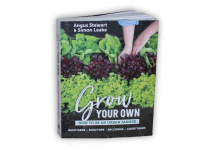There has been an explosion of interest in using earthworms to compost domestic organic waste such as kitchen scraps. The question is often asked as to whether composting worms such as tiger and red worms can be added to the garden. There are usually some species of earthworms in a normal garden soil but they are rarely the type that thrives in a worm farm.
Gardeners instinctively welcome the sight of earthworms when they are working their soil. Soil scientists have provided a lot of hard scientific evidence to substantiate the gut feelings of those of us who toil in the soil. No lesser than one of the great biologists of all times Charles Darwin was one of the first scientists to seriously consider the place of earthworms in soil biology. To quote Darwin, “Worms seem to be the great promoters of vegetation, perforating and loosening the soil, rendering it pervious to rains and the fibers of plants by drawing straws and stalks of leaves and twigs into it; and most of all, by throwing up such infinite numbers of lumps of earth called worm-casts, which being their excrement, is a fine manure for grain and grass. The earth without worms would soon become cold, hard-bound, and void of fermentation, and consequently sterile.”
Vermicomposting – composting with worms
Perhaps the most useful way to utilise earthworms is in the composting of organic wastes (often referred to as vermicomposting). They can be used on virtually any scale from small domestic worm farms to industrial scale units used on farms to compost animal manures and other organic materials. Many different units for home gardeners are readily available from councils and other outlets. These range from hanging bags, a single bin, multi level units where the levels can be swapped around and in ground units that can be dug into the soil. Each of these has their own advantages and uses.
The benefits of using worms versus normal composting
The digestive process of the earthworm is extremely efficient when compared to other composting technique. Vermicomposting results in a much more complete breakdown process. A recent study found that “through vermicomposting the humic substances showed an increase of 40 to 60 percent which was higher than the value obtained for the composting process.” Reference:Dominguez, Jorge; Edwards, Clive; and Subler, Scott; “A Comparison of Vermicomposting and Composting,” BioCycle, April 1997. The humic substances referred to are the ‘glue’ that cements soil particles together to greatly improve soil structure.
Another aspect of vermicomposting is its superior ability to release nutrients that are tied up in an unavailable form within complex organic molecules. English researchers Edwards and Lofty wrote in their 1977 work , The Biology of Earthworms, “An important feature is that during the processing of the wastes (manure) by earthworms, many of the nutrients they contain are changed to forms more readily taken up by plants, such as nitrate nitrogen, exchangeable phosphorus and soluble potassium, calcium, and magnesium. The most surprising result [of our research] was that even 5% of worm-worked animal waste in the worm-worked waste/commercial mixture had a significant effect on the growth of plants.”
Edwards and Lofty also shed considerable light on the stimulatory effect that earthworms have on the microbiology of the soil. “By shredding organic matter and contributing nitrogen, earthworms stimulate microbial decomposition. Soil microorganisms live in the worm’s gut as well as the surrounding soil and so the microbial content of casts is usually more concentrated than in surrounding soil. Microbial activity in casts improves soil structure by encouraging aggregation of particles. Microbial secretions (gums) and growth of fungal hyphae stabilize the worm cast. Worm-worked soil is relatively water-stable and will resist soil compaction and run-off due to rains.” Reference: Edwards, Clive, and Lofty, J.R., Biology of Earthworms, Chapman and Hall, London, 1977.
Using worm castings in potting mix
Further studies in the 1980’s by Edwards and other researchers further substantiated earlier results and they tested the use of worm castings as an additive for potting mixes.
A wide range of plants tested was successfully grown (including vegetables, shrubs and bedding plants) using straight vermicompost or or several mixes including 3:1 or 1:1 ratios of vermicompost to peat, loam, or pine bark. Plant growth was reported to be better with vermicompost than when recommended commercial growing media was used, and seeds germinated faster for most plant species grown in vermicompost.
The overall results pointed to the fact that vermicompost is a superb additive for potting mixes. A couple of notes of caution were issued, however. The type of feedstock used will greatly affect the nutritional content. In other words, if a low nutrient material such as paper or cardboard is used the resulting vermicompost will have significantly lower nutritional value than one manufactured from, say animal manure. Vermicompost often tends to be alkaline and consequently pH may need adjustment through the use of sulphur or iron sulphate. Reference: Edwards, C.A. and Neuhauser, E.F. (1988) Earthworms in Waste and Environmental Management. The Hague, Netherlands: SPB Academic Publishing.
It is obvious that the organic gardeners love of earthworms is firmly rooted in science and that the use of vermicomposting could and should become part of every gardeners recycling practices. Indeed, there is no such thing as organic wastes, only wasted organics!
For more worm farming information-
How do I know if my worm farm has the right moisture content?
What are the white maggots in your worm farm?
And worm videos-
Can you add citrus peel and onion skin to a worm farm?
Harvesting worm casting from your worm farm
For lots of information on home growing vegies, worm farming and lots more, check out the book
“Grow Your Own”….buy it here>>>>







